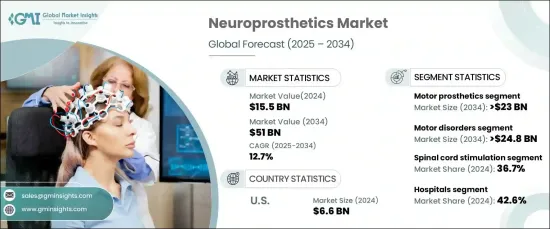PUBLISHER: Global Market Insights Inc. | PRODUCT CODE: 1665268

PUBLISHER: Global Market Insights Inc. | PRODUCT CODE: 1665268
Neuroprosthetics Market Opportunity, Growth Drivers, Industry Trend Analysis, and Forecast 2025 - 2034
The Global Neuroprosthetics Market was valued at USD 15.5 billion in 2024 and is poised for remarkable growth, projected to expand at a CAGR of 12.7% from 2025 to 2034. This growth is largely attributed to the rising prevalence of neurological disorders and the increasing adoption of cutting-edge wearable neuroprosthetic technologies. Enhanced healthcare accessibility in developing regions and growing awareness of neuroprosthetics' transformative benefits among patients and healthcare providers are further driving demand. Additionally, government support and funding initiatives for advanced neurological treatments are broadening the potential of these innovative devices.

By type, motor prosthetics are positioned to dominate the market, with a projected CAGR of 12.5%, reaching USD 23 billion by 2034. Groundbreaking advancements in brain-machine interfaces (BMIs) and neural control systems have revolutionized motor prosthetics, enabling seamless brain-to-device communication for natural and efficient movements. These technologies are playing an increasingly vital role in rehabilitation therapies, helping restore lost motor functions and solidifying the strong market presence of motor prosthetics.
| Market Scope | |
|---|---|
| Start Year | 2024 |
| Forecast Year | 2025-2034 |
| Start Value | $15.5 Billion |
| Forecast Value | $51 Billion |
| CAGR | 12.7% |
When categorized by technique, spinal cord stimulation (SCS) leads the market with a 36.7% share in 2024. SCS devices have become a cornerstone in the treatment of neuropathic pain, failed back surgery syndrome, and complex regional pain syndrome. Their proven efficacy in managing chronic pain has established them as the preferred solution for patients and healthcare providers alike, ensuring their sustained market dominance.
In the United States, the neuroprosthetics market accounted for USD 6.6 billion in 2024 and is expected to grow at a CAGR of 12% through 2034. Key factors fueling this growth include the country's aging population and the increasing incidence of neurological conditions such as Parkinson's disease and epilepsy. Robust reimbursement policies and the presence of leading manufacturers further bolster market expansion. Continuous advancements in medical technology and an intensified focus on neurological care firmly position the U.S. as a critical hub for innovation and growth in the global neuroprosthetics industry.
Table of Contents
Chapter 1 Methodology and Scope
- 1.1 Market scope and definitions
- 1.2 Research design
- 1.2.1 Research approach
- 1.2.2 Data collection methods
- 1.3 Base estimates and calculations
- 1.3.1 Base year calculation
- 1.3.2 Key trends for market estimation
- 1.4 Forecast model
- 1.5 Primary research and validation
- 1.5.1 Primary sources
- 1.5.2 Data mining sources
Chapter 2 Executive Summary
- 2.1 Industry 3600 synopsis
Chapter 3 Industry Insights
- 3.1 Industry ecosystem analysis
- 3.2 Industry impact forces
- 3.2.1 Growth drivers
- 3.2.1.1 Rising prevalence of neurological disorders
- 3.2.1.2 Advancements in neurotechnology
- 3.2.1.3 Growing adoption of wearable neuroprosthetics
- 3.2.2 Industry pitfalls and challenges
- 3.2.2.1 High costs of devices
- 3.2.1 Growth drivers
- 3.3 Growth potential analysis
- 3.4 Regulatory landscape
- 3.5 Reimbursement scenario
- 3.6 Technology landscape
- 3.7 Gap analysis
- 3.8 Porter's analysis
- 3.9 PESTEL analysis
- 3.10 Future market trends
Chapter 4 Competitive Landscape, 2024
- 4.1 Introduction
- 4.2 Company matrix analysis
- 4.3 Company market share analysis
- 4.4 Competitive analysis of major market players
- 4.5 Competitive positioning matrix
- 4.6 Strategy dashboard
Chapter 5 Market Estimates and Forecast, By Type, 2021 – 2034 ($ Mn)
- 5.1 Key trends
- 5.2 Motor prosthetics
- 5.3 Sensory prosthetics
- 5.4 Cognitive prosthetics
Chapter 6 Market Estimates and Forecast, By Application, 2021 – 2034 ($ Mn)
- 6.1 Key trends
- 6.2 Motor disorders
- 6.2.1 Parkinson disease
- 6.2.2 Epilepsy
- 6.3 Physiological disorders
- 6.3.1 Auditory disorders
- 6.3.2 Ophthalmic disorders
- 6.3.3 Cardiac disorders
- 6.3.4 Kidney disorders
- 6.4 Cognitive disorders
- 6.4.1 Alzheimer disease
- 6.4.2 Severe depression
Chapter 7 Market Estimates and Forecast, By Technique, 2021 – 2034 ($ Mn)
- 7.1 Key trends
- 7.2 Spinal cord stimulation
- 7.3 Deep brain stimulation
- 7.4 Vagus nerve stimulation
- 7.5 Sacral nerve stimulation
- 7.6 Transcranial magnetic stimulation
Chapter 8 Market Estimates and Forecast, By End Use, 2021 – 2034 ($ Mn)
- 8.1 Key trends
- 8.2 Hospitals
- 8.3 Clinics
- 8.4 Ambulatory surgical centers
- 8.5 Other end users
Chapter 9 Market Estimates and Forecast, By Region, 2021 – 2034 ($ Mn)
- 9.1 Key trends
- 9.2 North America
- 9.2.1 U.S.
- 9.2.2 Canada
- 9.3 Europe
- 9.3.1 Germany
- 9.3.2 UK
- 9.3.3 France
- 9.3.4 Spain
- 9.3.5 Italy
- 9.3.6 Netherlands
- 9.4 Asia Pacific
- 9.4.1 China
- 9.4.2 Japan
- 9.4.3 India
- 9.4.4 Australia
- 9.4.5 South Korea
- 9.5 Latin America
- 9.5.1 Brazil
- 9.5.2 Mexico
- 9.5.3 Argentina
- 9.6 Middle East and Africa
- 9.6.1 South Africa
- 9.6.2 Saudi Arabia
- 9.6.3 UAE
Chapter 10 Company Profiles
- 10.1 Advanced Bionics
- 10.2 Boston Scientific
- 10.3 Cochlear
- 10.4 Kernel
- 10.5 LivaNova
- 10.6 Med-El
- 10.7 Medtronic
- 10.8 NDI
- 10.9 Neuropace
- 10.10 nevro
- 10.11 Retina Implant
- 10.12 Second Sight
- 10.13 Sonova




